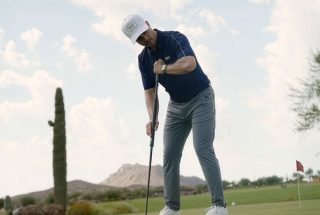Holland, Ohio – At the 2008 Tournament of Champions event, Golf Channel announcer Kelly Tilghman made a naive comment relating to Tiger Woods being “lynched” in a back alley by his fellow competitors. She didn’t mean anything by it other than to relate Tiger’s dominance at the time. She didn’t realize what the term meant.
This was followed by the instantly infamous Golfweek Magazine “Noose Issue” cover depicting a noose. At the 2008 PGA Merchandise Show Golfweek had a unique display set in the center of what I call “Broadway”, the main aisle at the show. They didn’t show up to man the booth, apparently hiding from the blowback the cover caused. Instead, in the center of the aisle sat an unoccupied table with a few issues of the magazine strewn on its surface.
I published the following article reflecting on these events and the 2008 show. Since then, technology has transformed golf with derivative “off course” forms. The established golf powers have superficially embraced these changes, yet their understanding of how to grow the game remains in the dark ages. The same is true of the industry as a whole.
To wit, “on course” participants have remained essentially static over the last decade and a half, while “off course” participants have grown on the order of six-fold. It makes me wonder why we even have these core established golf powers. It makes me wonder how golf might have grown if they hadn’t existed.
No soup for you!
January 21, 2008.
The 2008 PGA Merchandise Show is now one for the books, already a fading memory. Speaking as an exhibitor, the show is all-consuming and exhausting. Each year I walk through the show and feel pain as I pass the many 10’x10′ booths of startup golf purveyors, the majority of which will be out of business before the following year. But as with postpartum mothers, memories of this pain will disappear and only the joyful moments will remain lodged in the cerebral neural pathways.
For that reason it’s essential to timely reflect upon some collective observations before my over-protective brain files them in the subconscious drawer, perhaps not to be re-opened until the latter moments of my temporal decline. I’ve heard that sudden recollections of past pain can shock one’s psyche, so I’d like to deal with it now to avoid future personal trauma.
I experienced an epiphany of sorts last week. Perhaps what finally came into focus has been long known by many, as it certainly would not have required a sapient sleuth to gather the random data that rendered my slow-witted clarity.
Indeed, it has suddenly become conspicuously clear to me that an insidious virus has been infecting the golf industry my entire life. My painful epiphany is rooted in the sudden realization that the “manage the market” approach to business taken by the golf industry is prevalent within all of golf.
In fact, one could observe that golf has historically been a game with extraordinarily exclusionary principles. But somewhere along the way, the exclusionary game became a business–a business, like any other, where optimum success depends upon a concept the golf industry in general does not well comprehend: the “customer”.
The optimum success of “golf, the business” is to cater to, versus manage, the customer. “Golf, the game”, not being a for-profit institution, can perhaps do whatever it wants. But it’s not good business to pass judgment on our customers. In the mercantile nation passing judgment is the domain of the customer, not the purveyor. The purveyor’s role is to SATISFY the customer. Those that do it best usually make the most money. If the goal of business is to make money, then the goal is to do one’s best to satisfy the customer.
The golf business isn’t clear on this concept.
As I passed through security at the Orlando Airport on my way home, I couldn’t help but note the similarities air travel has with playing a round of golf. Both experiences are rife with rules and regimentation. Stand in line; show your boarding pass; unbundle all your belongings to be x-rayed; stand at attention with arms out; line up by row number to board the plane; put your belongings in the overhead bin; stay seated until told otherwise; turn off all electronic devices; fasten your seat belt; put your tray tables and seat backs into their full and upright positions; put a paper bag over your head and cluck like a chicken.
Ugh.
In taking a little time to walk the PGA Show floor I saw plenty of things to confirm that this regimentation is not going to end anytime soon. Particularly of note was the sample signage on display at booths of the many golf paraphernalia suppliers–signs that stated things like “No starting on tenth tee”, “Replace all divots”, “Keep carts on paths only”, “See starter before proceeding to tee”, “Course closed”, “No metal spikes”, “Proper attire required”…
It’s not that I’m against having procedural guidelines, but the presentation leaves a lot to be desired. Imagine if Saks Fifth Avenue had signage throughout the store of a similar nature, not that less experienced retailers haven’t been guilty of the likes of the classic, crudely scribbled “No shirt, no shoes, no service”.
During one revealing meeting with a major golf store chain I came to realize the bizarre practice of the major golf OEMs of being highly selective of where to place their merchandise. This has its roots in the long-gone tradition of only allowing golf pro shops to sell their clubs. But that changed two generations ago, and the chain I mention is a mature, established, quality operation with well over fifty stores. They were at the show to promote themselves to the manufacturers. They actually have a “Director of Vendor Relations”.
Even having previously heard many stories in the past of golf retail startups of the highest quality being turned down by the big club brands, I was taken aback by the fact that this established chain felt it necessary to create a high-paying position for an experienced person to nurture relationships with suppliers so they could be allowed to PAY THEM MONEY.
Nevertheless, I conclude that the golf industry as a whole is not intentionally exclusionary and/or disrespectful of customer dynamics. They are, simply, clueless.
Notwithstanding “golf, the game”, which remains highly exclusionary in some realms, I believe that “golf, the business”, is merely ignorant. And I think this ignorance is environmental, versus genetic. We of the golf world have grown up in an environment where the norm has been one of exclusion. We’ve been so close to the forest that we haven’t been able to recognize our misguidance. It has rendered us a deviant subculture, like used car dealers and aluminum siding salesmen.
Like the golf industry, Kelly’s news-making comments were born of ignorance. Kelly, like the golf industry, sincerely wants to do the right thing. We need to cut her some slack. She’s good for golf.
As for the “noose issue”, that’s another story–intense labor pains for those involved that I’m sure they hope will soon fade from memory.
Postscript:
Since the article above was published, the technology miracle has transformed the golf industry. There today are as many USA “off course only” golfers as “on course only” golfers. I stopped by a PopStroke facility in Sarasota, Florida this past Sunday. It was jammed beyond capacity. I admit it was about the lamest miniature golf course I’ve ever seen, yet it was mobbed with folks paying $20 for 18 holes and buying overpriced beer and chicken sandwiches.
The same phenomenon has been happening at TopGolf and their “me-too” copy-cats. The indoor simulator business is raging. I visited my first Clarity residential customer after PopStroke and he told me he almost never plays outdoors anymore–only in his sim.
We should all bow down to this new class of golf purveyor who clearly understands the concept of the customer. As a traditionalist, I just hope that off course golf doesn’t one day fully obsolete on course golf–but the empirical evidence to that point is piling up.
 About Clarity.Golf
About Clarity.Golf
Clarity.Golf (www.clarity.golf) is a golf technology company focused on launch monitors, simulators, related technologies–and in delivering free knowledge to these markets. Clarity.Golf’s team is made up of prime movers within the indoor golf industry, including brilliant folks around the world working daily to educate and advise the indoor golf markets, and to manifest next-generation technologies.
For more information email Bill Bales at billbales@clarity.golf, or text him at +1 419-470-9890




